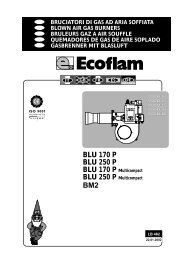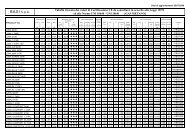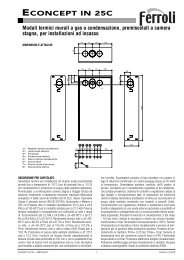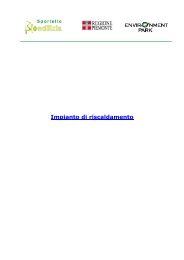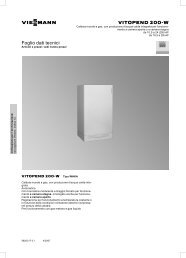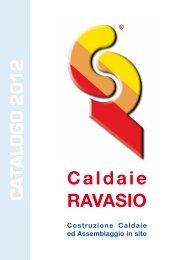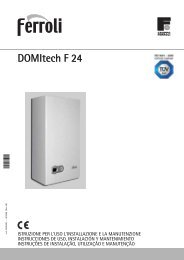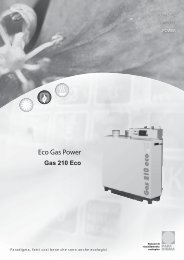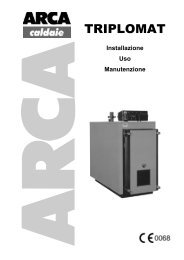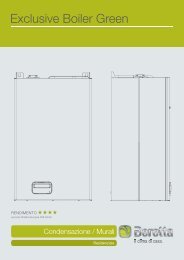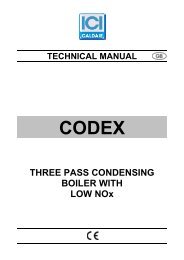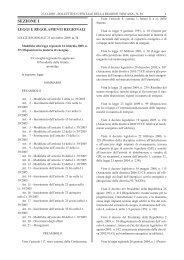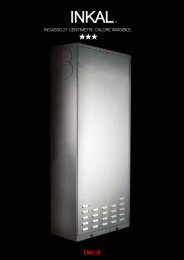aermec idrosplit - Certificazione energetica edifici
aermec idrosplit - Certificazione energetica edifici
aermec idrosplit - Certificazione energetica edifici
You also want an ePaper? Increase the reach of your titles
YUMPU automatically turns print PDFs into web optimized ePapers that Google loves.
FUNZIONAMENTO • OPERATION<br />
rata, che la temperatura dell’ acqua in circolazione scenda<br />
sotto i 40 °C.<br />
A questo punto si mettano in funzione i ventilconvettori: il<br />
progettista o l’installatore potranno fornire informazioni sul<br />
numero massimo di questi che possono funzionare contemporaneamente<br />
(potrebbero essere tutti quelli installati o solo<br />
alcuni: dipende dai carichi termici relativi ai vari ambienti).<br />
Se si mettessero in funzione più ventilconvettori di quanto<br />
consentito, il modulo ID non riuscirebbe a raffreddare completamente<br />
l’acqua in circolazione, e gli ambienti asserviti<br />
subirebbero un raffrescamento parziale. L’Idrosplit avverte<br />
l’utente di questa situazione tramite l’accensione della spia<br />
di sovraccarico (si veda più sotto).<br />
FUNZIONAMENTO INVERNALE<br />
Si richiamano qui le operazioni da eseguire per commutare<br />
da funzionamento estivo ad invernale, rimandando per ogni<br />
altra informazione alle istruzioni d’uso allegate alla caldaia.<br />
Per predisporre il Sistema Idrosplit in funzionamento invernale<br />
(distribuzione di acqua calda ai ventilconvettori) agire<br />
come segue:<br />
- accertarsi che il circuito idraulico non sia intercettato in nessun<br />
punto, e che quindi l’acqua possa circolare liberamente;<br />
- verificare che il modulo ID sia spento (interruttore 1 di fig.<br />
14 in posizione “zero”);<br />
- accendere la caldaia in funzionamento invernale, facendo<br />
riferimento alle istruzioni a corredo.<br />
BLOCCO DELLA CALDAIA • BOILER ALARM BLOCK<br />
Certi modelli di caldaie possono entrare in blocco nel caso<br />
in cui, per una manovra errata, vengano accesi contemporaneamente<br />
il modulo ID e la caldaia in funzionamento<br />
invernale, perchè ID blocca il flusso dell’acqua calda.<br />
Consultare le istruzioni a corredo della caldaia per le operazioni<br />
di sblocco. È comunque possibile evitare il verificarsi<br />
di tale eventualità facendo riferimento al capitolo<br />
“Collegamenti Elettrici”.<br />
Altre cause che possono provocare il blocco della caldaia<br />
ed i relativi rimedi sono descritte nel libretto istruzioni allegato<br />
all’apparecchio.<br />
REGOLAZIONE TEMPERATURA ACQUA FREDDA.<br />
All’accensione del modulo ID, la temperatura dell’acqua di<br />
ritorno dall’impianto (prima cioè che essa subisca il raffreddamento<br />
e venga inviata ai ventilconvettori), viene automaticamente<br />
impostata a 10 °C; questa temperatura è normalmente<br />
sufficiente a garantire il buon funzionamento<br />
dell’impianto di condizionamento. È possibile comunque<br />
regolare la temperatura dell’acqua di ritorno da 9 a 20 °C<br />
effettuando le seguenti operazioni:<br />
- tenere premuto il pulsante (2) di fig. 14, contrassegnato<br />
con il “cacciavite”; sul display viene visualizzata la temperatura<br />
impostata in precedenza;<br />
- impostare la temperatura dell’acqua di ritorno per mezzo<br />
dei tasti (4). Usare il tasto superiore per aumentare la temperatura<br />
e quello inferiore per diminuirla;<br />
- rilasciare il pulsante (2).<br />
REGOLAZIONE TEMPERATURA ACQUA DI RISCALDAMENTO<br />
Per il funzionamento con ventilconvettori, si consiglia una<br />
temperatura dell’acqua di mandata di circa 50 °C.<br />
Per la regolazione della temperatura, si faccia riferimento<br />
alle istruzioni della caldaia.<br />
In fig. 14 è riportato il pannello comandi del modulo ID. Il<br />
pannello è dotato dei seguenti comandi e segnalazioni:<br />
- interruttore (1) acceso-spento; svolge anche la funzione di<br />
pulsante di sblocco in caso di intervento delle sicurezze;<br />
- pulsante (2) per la visualizzazione o la modifica della<br />
temperatura di funzionamento impostata (set-point);<br />
ler can provide information on the maximum number of<br />
these that can operate simultaneously (it could be all those<br />
installed or only some: it depends on the thermal loads in<br />
the various rooms). If more fancoils start than permitted, the<br />
ID module would not be able to completely chill the water<br />
in circulation, and the rooms served would only be partially<br />
cooled. Idrosplit warns the user of this situation by lighting<br />
up the overload pilot light (see below).<br />
WINTER OPERATION<br />
Here we recall the operations to perform when commuting<br />
from summer to winter operation, leaving any other information<br />
to the boiler’s user instructions.<br />
To set the Idrosplit System in winter operation (distribution<br />
of hot water to fancoils) proceed as follows:<br />
- check that the hydraulic circuit has not been shut-off at<br />
any point, so that the water can circulate freely<br />
- check that the ID module is turned off (switch 1 in fig. 14,<br />
set to “zero”)<br />
- turn the boiler to winter operation, consulting the boiler<br />
user instructions<br />
Certain models will enter a block in the case where, for a<br />
wrong manoeuvre, they are turned on simultaneously with<br />
the ID module and the boiler in winter operation, because<br />
the ID blocks the water flow. Consult the boiler instructions<br />
for the resetting operations. It is nevertheless possible to<br />
avoid the arising of this eventuality referring to the chapter<br />
“Wiring Connections”.<br />
Other causes can provoke the boiler to block and relative<br />
remedies are described in the instruction booklet attached<br />
to the appliance.<br />
REGOLAZIONE TEMPERATURA ACQUA • WATER TEMPERATURE ADJUSTEMENT<br />
PANNELLO COMANDI • CONTROL PANEL<br />
CHILLED WATER TEMPERATURE ADJUSTMENT<br />
On turning on the ID module, the temperature of water<br />
returning from the plant (i.e. before it is subjected to cooling<br />
and is sent to the fancoils), is automatically set at 10°C. This<br />
temperature is normally sufficient to guarantee the correct<br />
operation of the air-conditioning plant. However, it is possible<br />
to adjust the return water temperature from 9 to 20°C,<br />
by carrying out the following operations:<br />
- keep button (2) pressed in fig. 14, marked with the<br />
“screwdriver” decal, the display shows the current temperature<br />
setting;<br />
- set the return water temperature with the keys (4). Use the<br />
top key to increase the temperature and the bottom key to<br />
reduce it;<br />
- release button (2).<br />
HEATING WATER TEMPERATURE ADJUSTMENT<br />
To operate the fancoils, we recommend a delivery temperature<br />
of the water of about 50°C.<br />
To adjust the temperature, consult the boiler instruction<br />
manual.<br />
Fig. 14 illustrates the ID module’s control panel. The panel<br />
is fitted with the following controls and pilot lights:<br />
- on/off switch (1). This also acts as the reset button in case<br />
of safety trips;<br />
- button (2) to display or adjust the set operating temperature<br />
(set-point);<br />
40



